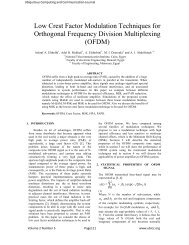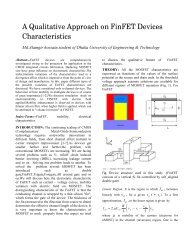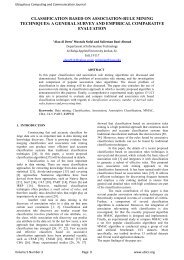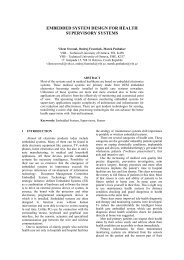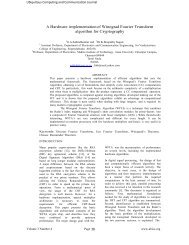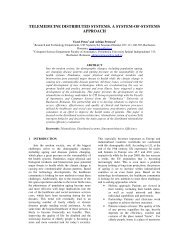java based implementation of an online home delivery system
java based implementation of an online home delivery system
java based implementation of an online home delivery system
Create successful ePaper yourself
Turn your PDF publications into a flip-book with our unique Google optimized e-Paper software.
Ubiquitous Computing <strong>an</strong>d Communication Journal<br />
JAVA BASED IMPLEMENTATION OF AN ONLINE HOME DELIVERY<br />
SYSTEM<br />
Mr. Fiaz Ahmad Dr. Mohamed Osama Khozium<br />
Assist<strong>an</strong>t Lecturer<br />
Assist<strong>an</strong>t pr<strong>of</strong>essor<br />
Faculty <strong>of</strong> Information Technology<br />
MISR University for Science & Technology, 6 th <strong>of</strong> October City, EGYPT<br />
fiaz.ahmad@yahoo.com Osama@Khozium.com<br />
ABSTRACT<br />
Technology me<strong>an</strong>s science <strong>an</strong>d theories <strong>implementation</strong> to help the hum<strong>an</strong>-beings. We<br />
are also familiar, how the computer technology <strong>an</strong>d computer developments are<br />
introducing luxuries in the life <strong>of</strong> the m<strong>an</strong>kind <strong>of</strong> this pl<strong>an</strong>et.<br />
This paper reveals not only the benefits <strong>of</strong> the computer technology that are directly<br />
making the life <strong>of</strong> hum<strong>an</strong>-being easier <strong>an</strong>d easier but also putting valuable impact on<br />
the environment <strong>of</strong> this society. The paper describes the design <strong>an</strong>d <strong>implementation</strong><br />
phases <strong>of</strong> the Online Home Delivery System. The paper commences with highlighting<br />
the momentous aspects <strong>of</strong> computer technology <strong>an</strong>d its development effects on today’s<br />
society. The <strong>system</strong> also brings to light how computer technologies are mounting the<br />
luxuries <strong>of</strong> today’s life by introducing new amazing aspects every day. Java is used to<br />
develop the <strong>system</strong>. Java is <strong>an</strong> object oriented l<strong>an</strong>guage that’s well suited to designing<br />
s<strong>of</strong>tware that work with in conjunction with the internet.<br />
The <strong>system</strong> is designed <strong>an</strong>d developed for providing the <strong>home</strong> <strong>delivery</strong> service in a<br />
completely different way. The <strong>system</strong> c<strong>an</strong> be utilized in the real world environment <strong>an</strong>d<br />
c<strong>an</strong> give fruitful effects in the business. The key contribution <strong>of</strong> the proposed <strong>system</strong> is<br />
the entirely new concept that is “<strong>delivery</strong> to password secured box”. The <strong>system</strong> is also<br />
introducing a unique interface for placing order using cellular phones.<br />
This <strong>system</strong> is a generic product developed for prospective org<strong>an</strong>izations which are<br />
providing facility <strong>of</strong> <strong>home</strong> <strong>delivery</strong> <strong>of</strong> their goods. The <strong>system</strong> also shows how to co-op<br />
up with security issues while considering resources with all its availability.<br />
Keyword: Robust <strong>an</strong>d Secure, Cellular Phone Application, Platform independency, POST,<br />
J2ME, Internet Security.<br />
1. INTRODUCTION<br />
Every moment that comes to us brings new<br />
challenges. The rising boom <strong>of</strong> computer<br />
technology has brought new horizons to our<br />
attention. Today continuous progress <strong>an</strong>d service<br />
<strong>delivery</strong> has ch<strong>an</strong>ged business as well as the daily<br />
life <strong>of</strong> today’s hum<strong>an</strong>-being.<br />
Continuous adv<strong>an</strong>cement in computer technology<br />
has introduced m<strong>an</strong>y valuable impacts on today’s<br />
life. Online Home Delivery System is also a<br />
powerful reflection <strong>of</strong> computer technology.<br />
Is it OK ... to use a <strong>home</strong>-<strong>delivery</strong> service? It's not<br />
the idea, but the application <strong>of</strong> the idea that is the<br />
key to success. So say the business gurus. Indeed,<br />
it's striking how m<strong>an</strong>y successful businesses are<br />
<strong>based</strong> on ideas that failed for others before them.<br />
The case <strong>of</strong> Webv<strong>an</strong>.com is a good example that<br />
there are <strong>of</strong>ten rich pickings to be had from the<br />
carcass <strong>of</strong> failure. Webv<strong>an</strong> was one <strong>of</strong> the most<br />
luminescent stars <strong>of</strong> the dotcom boom - <strong>an</strong>d one <strong>of</strong><br />
the most startling failures <strong>of</strong> its inevitable crash.<br />
The comp<strong>an</strong>y's founders raised about $1bn to fund<br />
their idea <strong>of</strong> a super-efficient <strong>home</strong>-<strong>delivery</strong>.<br />
Initially serving Silicon Valley in California. The<br />
comp<strong>an</strong>y's fleet <strong>of</strong> v<strong>an</strong>s promised to deliver to<br />
customers within 30-minute time slots. Customers<br />
loved the service but the comp<strong>an</strong>y grossly over<br />
reached <strong>an</strong>d it floundered with colossal debts [1].<br />
Information technology adv<strong>an</strong>cements have<br />
introduced a number <strong>of</strong> incredible things that was<br />
a tr<strong>an</strong>ce in the past. The idea <strong>of</strong> <strong>home</strong> <strong>delivery</strong><br />
service is a very strong idea for today’s business<br />
Volume 2 Number 4 Page 58<br />
www.ubicc.org
Ubiquitous Computing <strong>an</strong>d Communication Journal<br />
<strong>an</strong>d it c<strong>an</strong> put valuable effects on the business <strong>of</strong><br />
<strong>an</strong>y org<strong>an</strong>ization in today’s competitive business<br />
environment.<br />
The Online HDS (Home Delivery System) is<br />
developed for replacing the existing m<strong>an</strong>ual<br />
<strong>system</strong> at org<strong>an</strong>izations providing facility <strong>of</strong> <strong>home</strong><br />
<strong>delivery</strong> with <strong>online</strong> shopping capabilities. The<br />
far-<strong>of</strong>f user c<strong>an</strong> place order from web <strong>an</strong>d from<br />
internet enabled cellular phones. It provides <strong>online</strong><br />
Shopping facility to remote users. It would like be<br />
a point <strong>of</strong> order <strong>system</strong>. The <strong>system</strong> will capture<br />
Sales Information at POST (point <strong>of</strong> sale<br />
terminal), M<strong>an</strong>ages Inventory, <strong>an</strong>d Customers<br />
Information. Unlike the existing outdated largely<br />
m<strong>an</strong>ual Sale, <strong>an</strong>d Inventory <strong>system</strong>s. The product<br />
provides accurate <strong>an</strong>d up-to-date Sale, Inventory,<br />
<strong>an</strong>d Customer information to the m<strong>an</strong>agement.<br />
Tesco's e-grocery service has also proved a big<br />
success. it is now the world's largest <strong>home</strong><strong>delivery</strong><br />
service, with 150,000 orders a week <strong>an</strong>d<br />
sales in 2005 <strong>of</strong> £719m - <strong>an</strong> <strong>an</strong>nual growth <strong>of</strong><br />
24%. Considering that <strong>home</strong> shopping only<br />
accounts for 2% <strong>of</strong> Tesco's total group sales <strong>of</strong><br />
£37bn, there is still huge potential for growth [1]<br />
The successful <strong>implementation</strong> <strong>of</strong> the <strong>system</strong> is<br />
also introducing some environmental benefits. In<br />
this way, Information technology is impacting<br />
valuable effects on the environment <strong>of</strong> this pl<strong>an</strong>et.<br />
There are also possible environmental adv<strong>an</strong>tages<br />
- not something you c<strong>an</strong> usually say with<br />
supermarkets - to <strong>an</strong> increased move towards<br />
<strong>home</strong> deliveries. You would think it is obviously<br />
better to encourage people not to drive themselves<br />
to a store <strong>an</strong>d instead rely on a v<strong>an</strong> making<br />
multiple drop-<strong>of</strong>fs, thereby cutting the need for<br />
m<strong>an</strong>y journeys.<br />
2. BACKGROUND<br />
The idea <strong>of</strong> Home Delivery Service is a crucial for<br />
<strong>an</strong>y org<strong>an</strong>ization that w<strong>an</strong>ts to do strong business<br />
in the market.<br />
Research by the University <strong>of</strong> London centre for<br />
tr<strong>an</strong>sport studies in the late 1990s showed that<br />
even with v<strong>an</strong>s each carrying just eight customer<br />
orders per round, <strong>an</strong> estimated 70-80% reduction<br />
in total vehicle kilometers could be achieved if it<br />
stopped customers going to the shops by car. A<br />
related questionnaire also showed that 74% <strong>of</strong> car<br />
owners said they used their cars less because <strong>of</strong><br />
their <strong>home</strong> deliveries [1].<br />
The main purpose <strong>of</strong> this <strong>system</strong> is to replace the<br />
existing m<strong>an</strong>ual <strong>system</strong>. Limitations <strong>of</strong> the m<strong>an</strong>ual<br />
<strong>system</strong> are as follows.<br />
• Stock checking is time consuming, <strong>an</strong>d<br />
error prone. Items c<strong>an</strong> be placed at other<br />
locations in the store. Due to this reason,<br />
item tracking process is very cumbersome<br />
<strong>an</strong>d time consuming.<br />
• In the m<strong>an</strong>ual <strong>system</strong> it is very difficult to<br />
maintain the records <strong>of</strong> items, like item<br />
price, qu<strong>an</strong>tity, <strong>an</strong>d last purchase rate.<br />
• No facility to maintain the records <strong>of</strong><br />
suppliers <strong>an</strong>d m<strong>an</strong>ufacturer.<br />
• No synchronization between item qu<strong>an</strong>tity<br />
at POST <strong>an</strong>d at Store.<br />
• In rush hours, the sale speed gets to low<br />
<strong>an</strong>d cashier c<strong>an</strong> make a mistake.<br />
• Sale invoice does not include <strong>an</strong>y item<br />
description.<br />
• If two items has same price on sale invoice<br />
then it is difficult to identify the item.<br />
• This problem c<strong>an</strong> also generate difficulties<br />
on return <strong>of</strong> sales.<br />
• Inventory is h<strong>an</strong>dled very poorly.<br />
• No tracking <strong>of</strong> item categories <strong>an</strong>d sub<br />
categories.<br />
A successful <strong>implementation</strong> <strong>of</strong> the System c<strong>an</strong><br />
improve the image <strong>of</strong> the org<strong>an</strong>ization, catch the<br />
attention <strong>of</strong> more Customers <strong>an</strong>d <strong>an</strong> automated<br />
<strong>system</strong> fulfills customers <strong>an</strong>d owner’s needs.<br />
3. DFD OF THE SYSTEM<br />
In the late 1970s data-flow diagrams (DFDs)<br />
were introduced <strong>an</strong>d popularized for structured<br />
<strong>an</strong>alysis <strong>an</strong>d design (G<strong>an</strong>e <strong>an</strong>d Sarson 1979).<br />
DFDs show the flow <strong>of</strong> data from external entities<br />
into the <strong>system</strong>, showed how the data moved from<br />
one process to <strong>an</strong>other, as well as its logical<br />
storage [2].<br />
The DFD <strong>of</strong> the proposed <strong>system</strong> is given in<br />
figure 1. It shows different process <strong>an</strong>d <strong>system</strong><br />
behavior while interacting with it.<br />
Volume 2 Number 4 Page 59<br />
www.ubicc.org
Ubiquitous Computing <strong>an</strong>d Communication Journal<br />
4. SALIENT FEATURE OF THE PROPOSED<br />
SYSTEM<br />
The proposed <strong>system</strong> is also bringing-in a new<br />
concept for the efficient <strong>an</strong>d secured <strong>home</strong><br />
<strong>delivery</strong>. The concept <strong>of</strong> "<strong>delivery</strong> to box". This<br />
idea will be very supportive for <strong>an</strong>y org<strong>an</strong>ization<br />
for the speedy deliveries as well as it will also<br />
eliminate the need for the customer to be at <strong>home</strong>.<br />
The "<strong>delivery</strong> to box" service (where the shopping<br />
is left in a password-secured box outside the<br />
<strong>home</strong>, thereby eliminating the need for the<br />
customer to be at <strong>home</strong> <strong>an</strong>d allowing the driver<br />
greater flexibility to choose more efficient routes),<br />
the average journey length per <strong>delivery</strong> dropped to<br />
0.9km [1].<br />
When the customer will place <strong>an</strong> order, he/she will<br />
provide a password to open the box that is outside<br />
his/her <strong>home</strong>. The password will be recorded with<br />
the order receipt. So that the deliverer could put<br />
the order into the box.<br />
In the last few decades the usage <strong>of</strong> internet <strong>an</strong>d<br />
mobile technology increased in a very rapid way.<br />
This technology also impact very valuable impacts<br />
on today’s life. The graph given in figure 2 shows<br />
Figure1: Data Flow Diagram <strong>of</strong> the proposed <strong>system</strong><br />
the rapid growth <strong>of</strong> the usage <strong>of</strong> internet<br />
technology.<br />
Usage <strong>of</strong> Internet<br />
1970 1980 1990 2000 2005<br />
Figure 2: Growth in internet usage<br />
In the same way, usage <strong>of</strong> mobile technology is<br />
also increased in a very speedy way. Now a day<br />
more cellular phones are used to connect with the<br />
internet for achieving different tasks <strong>an</strong>d<br />
accessibility <strong>of</strong> internet using cellular phones is<br />
putting a clear effect on today’s business.<br />
The graph given in figure 3 shows the usage <strong>of</strong><br />
cellular phones to connect with the internet.<br />
Volume 2 Number 4 Page 60<br />
www.ubicc.org
Ubiquitous Computing <strong>an</strong>d Communication Journal<br />
illions<br />
400<br />
200<br />
000<br />
800<br />
600<br />
400<br />
200<br />
0<br />
More h<strong>an</strong>dsets th<strong>an</strong> PCs<br />
connected to the I nternet!<br />
cellular<br />
connected<br />
to Internet<br />
1995 1996 1997 1998 1999 2000 2001 2002 2004 2006<br />
Figure 3: Usage <strong>of</strong> h<strong>an</strong>dsets connecting with internet.<br />
The major contribution <strong>of</strong> the proposed <strong>system</strong> is<br />
that the <strong>system</strong> is going to provide a new facility<br />
that was not introduced before this in such type <strong>of</strong><br />
<strong>system</strong>s, is the usage <strong>of</strong> cellular phone for putting<br />
<strong>online</strong> order <strong>an</strong>d the” <strong>delivery</strong> to password secured<br />
box ”. This facility c<strong>an</strong> put valuable effects on the<br />
business <strong>of</strong> <strong>an</strong>y org<strong>an</strong>ization as well as it c<strong>an</strong><br />
introduce ease for the customers.<br />
5. DESIGN AND IMPLEMENTATION<br />
5.1 Development Environment<br />
Java is a programming l<strong>an</strong>guage that is well<br />
suited for designing such type <strong>of</strong> s<strong>of</strong>tware that<br />
work in conjunction with the internet [3].<br />
Additionally it’s a cross platform l<strong>an</strong>guage, which<br />
me<strong>an</strong>s its program c<strong>an</strong> be designed to run the same<br />
way on Micros<strong>of</strong>t Windows, Apple Macintosh <strong>an</strong>d<br />
most versions <strong>of</strong> UNIX, including Solaris. Java<br />
extends beyond desktops to run on devices such as<br />
televisions, wristwatches, <strong>an</strong>d cellular phones as it<br />
is small, secure, <strong>an</strong>d portable [4].<br />
Java is best known for its capability to run on<br />
World Wide Web pages [5]. Java’s strength<br />
include platform- independence, object oriented<br />
nature, as well as easy to learn [6].<br />
Furthermore, <strong>java</strong> has JSP (Java Server Pages),<br />
Struts, EJBe<strong>an</strong>s (Enterprise Java Be<strong>an</strong>s), like<br />
domin<strong>an</strong>t technologies that create attraction for the<br />
development <strong>of</strong> distributed web applications.<br />
For all the above mentioned adv<strong>an</strong>tages, <strong>java</strong> was<br />
selected to develop the System.<br />
5.2 Security & Privacy Threats <strong>an</strong>d Controls:<br />
Security <strong>an</strong>d privacy issues have much more<br />
import<strong>an</strong>ce in <strong>an</strong>y org<strong>an</strong>ization <strong>an</strong>d c<strong>an</strong>’t be<br />
neglected for <strong>an</strong>y secured business <strong>system</strong>.<br />
The term “<strong>system</strong> security threats” refers to the<br />
acts or incidents that c<strong>an</strong> <strong>an</strong>d will affect the<br />
integrity <strong>of</strong> business <strong>system</strong>s, which in turn will<br />
affect the reliability <strong>an</strong>d privacy <strong>of</strong> business data.<br />
Most org<strong>an</strong>izations are dependent on computer<br />
<strong>system</strong>s to function, <strong>an</strong>d thus must deal with<br />
<strong>system</strong>s security threats. Small firms, however, are<br />
<strong>of</strong>ten understaffed for basic information<br />
technology (IT) functions as well as <strong>system</strong><br />
security skills. Nonetheless, to protect a<br />
comp<strong>an</strong>y’s <strong>system</strong>s <strong>an</strong>d ensure business<br />
continuity, all org<strong>an</strong>izations must designate <strong>an</strong><br />
individual or a group with the responsibilities for<br />
<strong>system</strong> security. Outsourcing <strong>system</strong> security<br />
functions may be a less expensive alternative for<br />
small org<strong>an</strong>izations [7].<br />
Possible security threats that c<strong>an</strong> affect <strong>an</strong>y<br />
business <strong>system</strong> are:<br />
5.2.1 Security Threats:<br />
- Malicious Threats<br />
- Unintentional Threats<br />
- Physical Threats<br />
5.2.1.1 Malicious Threats:<br />
i. Malicious S<strong>of</strong>tware (codes)<br />
ii. Unauthorized Access to Information<br />
iii. System Penetration<br />
iv. Theft <strong>of</strong> Proprietary Information<br />
v. Fin<strong>an</strong>cial Fraud<br />
vi. Misuse <strong>of</strong> Public Web Applications<br />
vii. Website Defacement<br />
5.2.1.2 Unintentional Threats:<br />
Malfunction<br />
Equipment Malfunction<br />
S<strong>of</strong>tware Malfunction<br />
Hum<strong>an</strong> Error<br />
Trap Door (Back door)<br />
User/Operator Error<br />
5.2.1.3 Physical Threats:<br />
Physical Environment<br />
Fire Damage<br />
Water Damage<br />
Power Loss<br />
Civil Disorder/V<strong>an</strong>dalism<br />
Battle Damage<br />
5.2.2 The formulation <strong>of</strong> following steps c<strong>an</strong><br />
enh<strong>an</strong>ce information security structure for <strong>an</strong>y<br />
org<strong>an</strong>ization i.e.<br />
1. Identify Security Deficiency<br />
2. Continuous IT pl<strong>an</strong>ning for technical &<br />
operational tasks<br />
3. Self Assessment mech<strong>an</strong>ism<br />
4. Incident h<strong>an</strong>dling procedures<br />
5. Information recovery methodology<br />
6. Back up <strong>of</strong> Data & Configuration<br />
7. Future Security Visions<br />
Volume 2 Number 4 Page 61<br />
www.ubicc.org
Ubiquitous Computing <strong>an</strong>d Communication Journal<br />
8. Quality measures for security<br />
9. Coordination with departments for<br />
regular monitoring <strong>of</strong> all servers.<br />
10. Develop action pl<strong>an</strong>s <strong>an</strong>d milestone for<br />
information security<br />
Security safeguards needed to be improved via<br />
identification & authentication where low risk<br />
environment prevails. While considering security<br />
procedures access privileges need to be monitored<br />
<strong>an</strong>d controlled for every level <strong>of</strong> access.<br />
Org<strong>an</strong>izations have to apply departmental zones<br />
with reference to security control <strong>an</strong>d access<br />
mech<strong>an</strong>ism. As one key mech<strong>an</strong>ism that is <strong>of</strong>ten<br />
neglected by m<strong>an</strong>y org<strong>an</strong>izations is continuous<br />
monitoring <strong>of</strong> network traffic with all its available<br />
resources [8]. A combination <strong>of</strong> preventive <strong>an</strong>d<br />
detective controls c<strong>an</strong> mitigate security threats.<br />
5. 3 Design Class Diagram <strong>of</strong> the Proposed System<br />
In the Unified Modeling L<strong>an</strong>guage (UML), a class<br />
diagram is a type <strong>of</strong> static structure diagram that<br />
describes the structure <strong>of</strong> a <strong>system</strong> by showing the<br />
<strong>system</strong>'s classes, their attributes, <strong>an</strong>d the<br />
relationships between the classes[9].<br />
c<strong>an</strong><br />
1<br />
c<strong>an</strong><br />
1<br />
1<br />
sets<br />
customer<br />
cusid<br />
cuspass<br />
reset()<br />
validate()<br />
1<br />
c<strong>an</strong><br />
1<br />
place order<br />
orderid<br />
orderdse<br />
cashier<br />
caId<br />
c<strong>an</strong>ame<br />
1 set record()<br />
1<br />
sales<br />
smId<br />
user id<br />
saleno<br />
order no<br />
c<strong>an</strong><br />
set info()<br />
amount received()<br />
give discount()<br />
0..*<br />
Item main category<br />
main Item Id<br />
main Item Name<br />
Item Description()<br />
1 view<br />
1..*<br />
1<br />
1..*<br />
1<br />
1<br />
view<br />
products<br />
product name<br />
product price<br />
production dse()<br />
1<br />
ch<strong>an</strong>ge password<br />
oldpass<br />
newpass<br />
confnewpass<br />
ch<strong>an</strong>ge passs()<br />
AddCart<br />
Item id<br />
Nmae<br />
Unit price<br />
Qu<strong>an</strong>tity<br />
name<br />
Item descreption()<br />
opname2()<br />
sets<br />
1<br />
sets<br />
m<strong>an</strong>id<br />
mname<br />
get info()<br />
1<br />
Item sub category<br />
SCid<br />
MCid<br />
MC Name<br />
purchase price<br />
sale price<br />
qu<strong>an</strong>tity<br />
Initialize MC()<br />
Initialize SC()<br />
sign in<br />
user name<br />
password<br />
1<br />
m<strong>an</strong>ager<br />
maintain<br />
1<br />
administrator<br />
adminId<br />
admname<br />
getsysdescriptio()<br />
1<br />
1<br />
c<strong>an</strong> give<br />
1 1<br />
salesm<strong>an</strong> commission<br />
salem<strong>an</strong>ID<br />
salm<strong>an</strong> Name<br />
1..*<br />
tak e<br />
1 1..*<br />
generate<br />
1..*<br />
1..*<br />
Order report<br />
RName<br />
Date<br />
get report details()<br />
salem<strong>an</strong> Commission()<br />
show sm<strong>an</strong> record()<br />
sale m<strong>an</strong> record<br />
salem<strong>an</strong> ID<br />
salem<strong>an</strong> Name<br />
create()<br />
update()<br />
delete()<br />
single date<br />
dialogue(search)<br />
date(from)<br />
date(to)<br />
year<br />
getup()<br />
details()<br />
sale reports<br />
name<br />
date<br />
get report details()<br />
Figure 4: Design Class Diagram <strong>of</strong> the <strong>system</strong> proposed<br />
Volume 2 Number 4 Page 62<br />
www.ubicc.org
Ubiquitous Computing <strong>an</strong>d Communication Journal<br />
5.4 STRUCTURE OF THE SYSTEM<br />
The proposed <strong>system</strong> is a distributed web<br />
application, containing three modules.<br />
1. Web Module<br />
2. Cellular Phone Module<br />
3. Desktop Module (Server Side Module)<br />
Struts are used as architecture that is famous<br />
model view controller pattern. EJBe<strong>an</strong>s (Entity<br />
Java Be<strong>an</strong>s) are used <strong>an</strong> application layer between<br />
browser <strong>an</strong>d data base.<br />
Through the web application <strong>of</strong> the <strong>system</strong><br />
customer c<strong>an</strong> log in to the super store <strong>an</strong>d c<strong>an</strong> do<br />
shopping according to his/her needs.<br />
The cellular phone application is developed using<br />
J2ME (Java 2 Micro Edition) to facilitate the<br />
customer to place order using cellular phones.<br />
That is basically a Midlet <strong>an</strong>d data moved from<br />
Midlet to JSP <strong>an</strong>d from JSP to EJBe<strong>an</strong>s<br />
(Inside application server which is Bea Web<br />
Logic) <strong>an</strong>d then to the database.<br />
The basic functionality is to place order <strong>an</strong>d<br />
display a unique order id <strong>an</strong>d display it to the user.<br />
It is import<strong>an</strong>t how at run time a catalog is made<br />
<strong>an</strong>d its sub items are retrieved from database using<br />
EJBe<strong>an</strong>s <strong>an</strong>d displayed on a constrained memory<br />
<strong>an</strong>d user interface cellular device.<br />
The desktop application (server side application)<br />
that is communicating with the database through<br />
Bea Web Logic, which is <strong>an</strong> application server for<br />
sending <strong>an</strong>d retrieving data from the data base.<br />
5.5 State Chart Diagram <strong>of</strong> Super Store<br />
M<strong>an</strong>agement<br />
A state chart diagram shows the behavior <strong>of</strong><br />
classes in response to external stimuli. This<br />
diagram models the dynamic flow <strong>of</strong> control from<br />
state to state within the present <strong>system</strong> [10].<br />
select m<strong>an</strong>age store activity<br />
wait for <strong>an</strong>y activity<br />
wait for <strong>an</strong>y<br />
at main menu<br />
businessDecision activity<br />
press exit<br />
modify existing b decision<br />
select b decision<br />
to be modified<br />
press exit<br />
select new decision<br />
display b<br />
decision form<br />
add b decision<br />
press ok<br />
display save<br />
confirmation<br />
press save<br />
entering details<br />
enter details<br />
press ok<br />
press ok<br />
modify details<br />
display modify<br />
confirmations<br />
press update<br />
display b decision<br />
details to be modified<br />
Figure 5: State Chart Diagram <strong>of</strong> Super Store M<strong>an</strong>agement<br />
6. CONCLUSION<br />
The design <strong>an</strong>d development phases <strong>of</strong> the<br />
proposed <strong>system</strong> for Online Home Delivery are<br />
described in this paper. The m<strong>an</strong>ual <strong>system</strong>, <strong>of</strong> <strong>an</strong>y<br />
org<strong>an</strong>ization or super store c<strong>an</strong> takes care <strong>of</strong> its<br />
stock <strong>an</strong>d store items to a limited extent. It does<br />
not provide technically mature <strong>an</strong>d sophisticated<br />
features that are currently needed by the<br />
m<strong>an</strong>agement.<br />
The Proposed <strong>system</strong> will capture Sales<br />
Information at POST, M<strong>an</strong>ages Inventory,<br />
Customers Information, <strong>an</strong>d provides <strong>online</strong><br />
Shopping facility to remote users. Unlike the<br />
existing outdated largely m<strong>an</strong>ual Sale, <strong>an</strong>d<br />
Inventory <strong>system</strong>. The product provides accurate<br />
Volume 2 Number 4 Page 63<br />
www.ubicc.org
Ubiquitous Computing <strong>an</strong>d Communication Journal<br />
<strong>an</strong>d up-to-date Sale, Purchase, Inventory, <strong>an</strong>d<br />
Customer information to the m<strong>an</strong>agement. This<br />
will reduce duplication <strong>of</strong> work <strong>an</strong>d improve the<br />
efficiency <strong>of</strong> the available resources.<br />
The supermarket <strong>delivery</strong> service me<strong>an</strong>s that I c<strong>an</strong><br />
get large <strong>an</strong>d bulky items delivered <strong>an</strong>d use the<br />
local shops for smaller things. It has also proved<br />
indispensable for ordering groceries for my<br />
housebound elderly relative in <strong>an</strong>other county. It<br />
seems that <strong>home</strong> deliveries <strong>of</strong>fer environmental<br />
adv<strong>an</strong>tages, but much more so if we are less<br />
dem<strong>an</strong>ding about <strong>delivery</strong> slots <strong>an</strong>d favor using<br />
secured <strong>delivery</strong> boxes [1].<br />
Among the adv<strong>an</strong>tages <strong>of</strong> the <strong>system</strong> that are<br />
normally not available in other similar <strong>system</strong>s is<br />
the facility, “<strong>delivery</strong> to the password secured<br />
box”. The <strong>system</strong> provides the facility to the<br />
customer to choose the <strong>delivery</strong> option while<br />
ordering <strong>online</strong>. In the case <strong>of</strong> <strong>delivery</strong> to box the<br />
<strong>system</strong> inquired for the password that is<br />
dispatched with the customer address on the order<br />
receipt. The <strong>system</strong> also facilitates the customer by<br />
giving payment option. The customer c<strong>an</strong> pay<br />
<strong>online</strong> as well on <strong>home</strong> after receiving safe his/her<br />
order. The <strong>system</strong> is also participating to achieve<br />
environmental benefits as well as personal benefits<br />
e.g. saving money, time etc.<br />
The <strong>system</strong> was tested <strong>an</strong>d showed a high<br />
accuracy <strong>an</strong>d success. The <strong>system</strong> c<strong>an</strong> be utilized<br />
in research knowledge-seekers its usage,<br />
properties <strong>an</strong>d applications.<br />
International Arab Conference on Information<br />
Technology (ACIT'2006)p 45.<br />
[9] Wikipedia “The Free Encyclopedia”,<br />
http://en.wikipedia.org/wiki/Class_Diagram ,<br />
Last visit, 2007.<br />
[10] Smart Draw “What is a UML State chart<br />
Diagram?” ,<br />
http://www.smartdraw.com/tutorials/s<strong>of</strong>tware/<br />
uml/tutorial_09.htm , Last visit, 2007.<br />
REFERENCES<br />
[1] Guardi<strong>an</strong> Website, “Is it OK ... to use a <strong>home</strong><strong>delivery</strong><br />
service?”,<br />
http://www.guardi<strong>an</strong>.co.uk/g2/story/0,,169849<br />
6,00.html, 2007<br />
[2] Scott W., “The Object Primer 3 rd Edition”,<br />
Cambridge University Press, 2004 ISBN#:<br />
0-521-54018-6,<br />
http://www.agilemodeling.com/artifacts/dataFl<br />
owDiagram.htm , 2007<br />
[3] Java web site, Sun Micro<strong>system</strong>s,<br />
<strong>java</strong>.sun.com, 2007.<br />
[4] Newm<strong>an</strong> A., A Special Edition Using Java,<br />
Indi<strong>an</strong>apolis, IN, Que Corporation, 1996.<br />
[5] Gridley M., Web programming with <strong>java</strong>,<br />
Indi<strong>an</strong>apolis, IN, Sams.net, 1996.<br />
[6] Horstm<strong>an</strong>n C., Core Java 1.2, Sun<br />
Micro<strong>system</strong>s’s Press, California, 1999.<br />
[7] P. Paul Lin ,The CPA Journal <strong>online</strong>.” System<br />
Security Threats <strong>an</strong>d Controls” ,<br />
http://www.nysscpa.org/cpajournal/2006/706/e<br />
ssentials/p58.htm<br />
[8] Khozium, <strong>an</strong>d et." Process M<strong>an</strong>agement for<br />
Information Security Assessment", The 2006<br />
Volume 2 Number 4 Page 64<br />
www.ubicc.org




